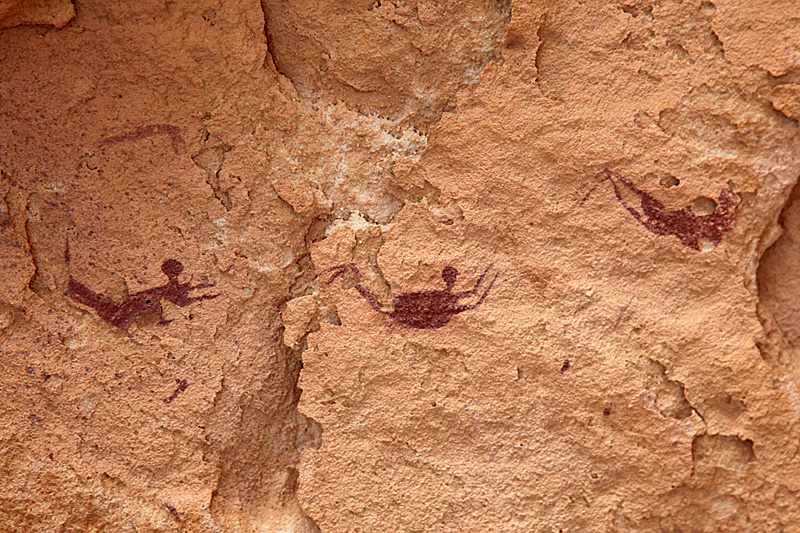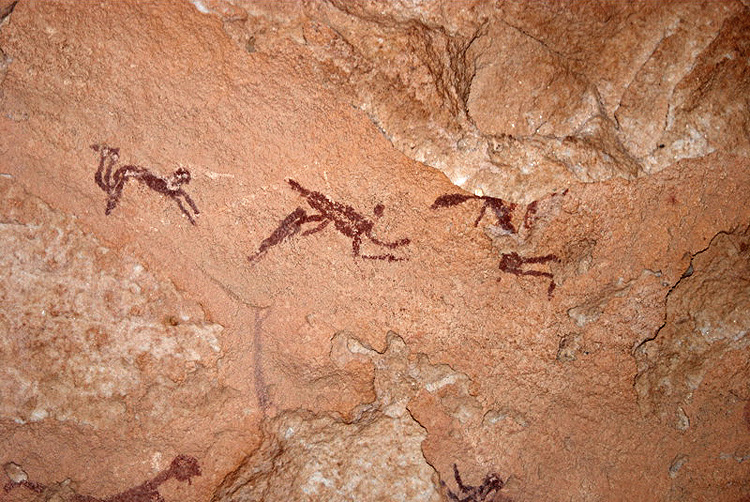Thousands of years ago, the Sahara was surprisingly green with rich vegetation, trees and lakes that covered almost all of what is now sandy desert. There were vast open grasslands, forests, rivers, lakes and wetlands, that allowed a variety of animal species to survive. Antelopes, gazelles, giraffes, elephants, wildebeest, spotted hyenas, zebras and more roamed the savannah, while crocodiles baked in the river banks and hippos rolled in the mud. Evidence of the Sahara’s amiable past is recorded in the rocks—in the form of fossils, and petroglyphs and rock paintings by humans who lived during this period. One well-known such petroglyph location is the Cave of Swimmers in the remote Gilf Kebir mountains in southwest Egypt near the Libyan border.

Do these petroglyphs in the Sahara depict people swimming? Photo: Roland Unger/Wikimedia Commons
The Cave of Swimmers was discovered by the Hungarian explorer László Almásy in October 1933. The cave contains tiny artwork of what appears to be people swimming. The paintings are estimated to have been created during the Neolithic period, about 8,000 years ago.
László Almásy, in his book The Unknown Sahara, postulates that the swimming scenes are real depictions of life at the time of painting, suggesting that there had been a climatic change from temperate to desert. At that time it was a radical new theory that sounded so dubious that his publisher felt compelled to add several footnotes in the book to make it clear that they did not share this opinion.
László Almásy’s theory was sensational, but it was not entirely new. Many ancient historians, such as Herodotus and Strabo, mention the existence of a humid and vegetated Sahara, but these statements were not taken seriously by scientists because of their anecdotal nature. However, more and more evidence began to emerge in the second half of the 20th century that showed that during the early and mid-Holocene, subtropical North Africa was much more humid than it is today. In this period, now known as the African Humid Period, there were lush green forests in the vicinity of lakes and rivers, and smaller shrubs in other areas. Perennial lakes were abundant and lake levels were much higher.

Image credit: Ingoman/Wikimedia Commons

Image credit: Juan C. Larrasoaña, Andrew P. Roberts, Eelco J. Rohling
Some 6,000 to 5,000 years ago, the climate began to change and vegetation declined. The Sahara became barren and was claimed by sand blown from dried up lakes. The drying up of the Sahara forced humans to move to the Nile, where the society of Ancient Egypt with pharaohs and pyramids was eventually forged by these climate refugees.
László Almásy is one of handful of explorers who ventured into the Libyan desert in the late 1920s and early 1930s. In 1932, Almásy embarked on an expedition to find the legendary Zerzura, “The Oasis of the Birds,” along with three other British explorers. The men took with them an airplane and while surveying the desert from the air, they discovered three hidden valleys with vegetation in the northern Gilf Kebir. However, all attempts to reach the mouth of the valley failed.
In 1933, Almásy embarked on another expedition, this time with the noted German ethnographer Leo Frobenius, and succeeded in entering the elusive valleys. László Almásy discovered many prehistoric rock art sites including the Cave of Swimmers at Wadi Sora. A fictional account of his travels was depicted in the movie The English Patient, where László Almásy was played by Ralph Fiennes.

Petroglyphs from the cave of swimmers. Photo: Bradshaw Foundation

Petroglyphs from the cave of swimmers. Photo: Roland Unger/Wikimedia Commons
References:
# Theory and Modeling of the African Humid Period and the Green Sahara, Oxford
# The Cave of Swimmers, Bradshaw Foundation
# Wikipedia



Comments
Post a Comment